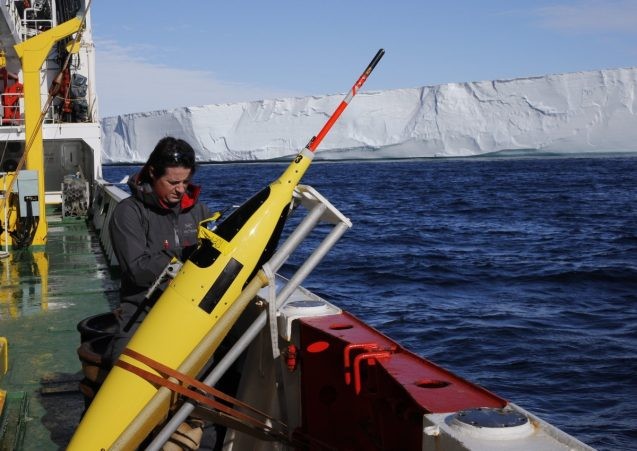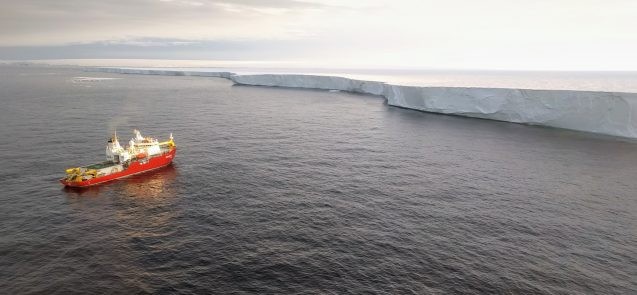Refining Projections of Antarctic Ice Loss and Global Sea Level Rise
Research by Center for Climate and Life Fellow Pierre Dutrieux will lead to greater understanding of the West Antarctic Ice Sheet’s future stability and associated sea level rise.

Antarctica is rapidly shedding ice, a loss that contributes to rising seas. Research demonstrates that human-induced global climate change and warming ocean temperatures are the main culprits behind the ice loss. But the rate of ice loss and how much it may raise global sea levels remain uncertain.
Pierre Dutrieux, an oceanographer and assistant research professor at Lamont-Doherty Earth Observatory, received funding from Columbia University’s Center for Climate and Life for a project that will resolve some of this uncertainty. Named a Center Fellow in 2019, Dutrieux uses new data and methods to examine the thinning and melting of the massive West Antarctic Ice Sheet. The results of his research will enable the scientific community to better project the future stability of the ice sheet and associated sea level rise.
What’s the focus of your research?
In climate science, a main issue with imminent, global repercussions is sea level rise, of which the eustatic component—that related to land ice flowing into the ocean—is an important contributor. Acceleration of West Antarctic glaciers flowing into the Southern Ocean alone contributes roughly 10 percent of current sea level rise. Our lack of understanding of the processes at play constitutes the lion’s share of the global sea level rise uncertainty going into the future.
The glaciers’ acceleration is attributed to the thinning of the glacier buttressing ice shelves, driven by oceanic melting. In turn, this melting contributes to a freshening of polar waters, altering sea-ice formation, the density of global abyssal waters, and global thermohaline ocean circulation. We must concentrate our efforts on the interaction between the ocean and the ice and the processes driving their coupled behavior if we are to understand these systems.
My work focuses on that interaction. I’m particularly interested in the broad range of spatial and temporal scales over which it occurs, and the fact that ice sheets, instead of being immovable white giants, also react dynamically over unexpectedly short timescales. Because most of the changes occur at the interface between the two systems, ground and ocean-based surveys are essential. I’ve used many interesting technologies, including various autonomous underwater vehicles, to explore this hidden frontier.
What’s the problem you’re trying to address with your Climate and Life funding?
In 2016, I obtained funding from the Paul G. Allen Family Foundation in close collaboration with colleagues at the University of Washington for an extensive field campaign. This program pioneered new, long endurance and relatively inexpensive autonomous platforms for under-ice observations. Three Seagliders and four EM-APEX floats were launched under the Dotson Ice Shelf in the Amundsen Sea, West Antarctica. The campaign was a large success, consisting of 14 months (January 2018–March 2019) and hundreds of kilometers of continuous measurements near and under the Dotson Ice Shelf.
This project increases the global amount of under-ice observations by an order of magnitude. It provides unique observations near—roughly less than one meter—the ice, which was largely avoided by previous efforts. Completed by other sources, this dataset will be the main focus of my investigations over the next few years. I’ll address the following questions: What is the main source of the interannual wind variability in the Amundsen Sea? What is the contemporaneous seasonal to decadal variability in ocean heat available for melting the ice shelves in the Amundsen Sea? Are ice shelf cavities tightly or weakly connected to this oceanic variability? Is the parameterization of ocean and ice exchanges currently used in Earth system models valid?

What do you find most exciting about your Climate and Life project?
This project is exciting because it will allow the exploration of a unique and remarkable dataset, from a place we know very little about to date. Discoveries await!
How might this project advance understanding of the challenges posed by climate change?
This project will provide critical insight into the climate forcing that controls the oceanographic environment of all glaciers in the wider Amundsen Sea Embayment. The future of these outlet glaciers and global sea level rise over the next century cannot be confidently projected without this insight.
What’s something happening in the realm of climate solutions that gives you hope?
Hope can seem like a distant companion in these days of a global pandemic, civil unrest reacting to seemingly atemporal racial injustice, and an economic crisis. Over long—one may say climatic—timescales, however, positive movements abound everywhere. Climate science and the solutions it will provide, share a similar trajectory. About a decade ago, when I was entrained into this field of research by visionary colleagues, it seemed like only a few of us were focusing on ice-ocean interactions. Today the field is growing exponentially, with many young and talented researchers challenging themselves to provide important findings, improve understanding of ice-ocean interactions, and increase our predictive power. Being part of such a movement is certainly enthusing. It gives me hope that a clear global sea level rise projection will shift the political landscape to take the necessary, science-based, preventative actions to limit the suffering to come.
Related: Center for Climate and Life Fellow Explains IPCC Sea Level Warning
This post was first published by the Center for Climate and Life, a research initiative based at Columbia University’s Lamont-Doherty Earth Observatory.
